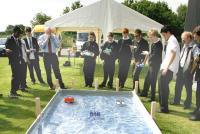
Solar Boat Challenge
The Solar Boat Challenge is intended to promote and develop:
- an interest in Engineering and Technology
- and the use of solar power with school children
It is hoped that by doing this our future citizens, scientists and engineers will be more aware of, and participate in, a more environmentally friendly approach to energy usage.
The Solar Boat Challenge comes from Australia (where the sun shines brightly) and you can get more information from these two sites:
Inspirations and the Rotary Club
The North Yorkshire Inspirations Event Steering Group with the support of the Rotary Club of the York Vikings thought that it was a good idea and decided to issue a challenge.
Challenge
The challenge will take place at the Annual Inspirations Day at the Elvington Air Museum.
Entries can be from individuals or groups up to a maximum of group size of four.
Participants will be asked to design and construct a solar powered boat and then race them in a specially constructed pool.
The contestants will be divided in to groups by Key Stage and there will be a competition for each group.
How to enter the competition
The competition is open to students in key stages 2, 3 and 4.
Entry to the competition is free and is sponsored by the Rotary Club of the York Vikings.
Schools wishing to enter students should make their intentions to Yvonne Emerson at NYBEP (see contact details below) as soon as possible when they will receive a FREE entry kit.
Entrants may wish to bring along any research work they have done prior to the day as well as their brains and a small tool kit for maintenance purposes.
E.I. Regulations and Specifications
- The maximum length of the boat shall not exceed 550mm
- The maximum width of the boat shall not exceed 300mm including any methods of propulsion such as paddle wheels or oars.
- The boat must be fitted with stiff wire hooks to fit loosely over the guide wire that keeps the boat on a straight line whilst going down the tank.

- Only one motor can be used and a maximum of three solar cells are allowed per boat.
- Only one propeller or water screw is allowed per boat but no limit is put on the size of them and any numbers of paddle wheels or oars are allowed.
- No commercially produced boat hulls are allowed and all boats must be constructed by the contestants who enter them.
- No batteries are allowed but capacitors may be used in the electrical circuit.
- The solar cells and motors must be fitted to the hull in such away as not to be a danger to the operator or other contestants and the solar cells must not be able to fall off into the water.
- A switch must be installed between the motor and the solar panels, to allow the engine to be turned off easily. The switch may consist of a plug or clip which is removed.
- All races will be run in the recognised tank which will be orientated north to South.
- The winner of each category will be the boat deemed by the judges to have covered the length of the tank in the shortest time and to have adhered to the rules. In the event of a tie the tying boats will take part in a best of three lengths of the tank going in alternate directions all other races will take place in the same direction.
- Prizes will also be awarded for Best use of Materials and The most Innovative Design.
- In the event of any dispute the decision of the senior judge is final and the decision will be based on fairness and the guiding principles of friendly competition.
Competition research
Some useful areas of research would be:
- Solar panels and how to wire them up.
- Capacitors and capacitance.
- Buoyancy.
My Notes Investigation and preparation
After a lot of experimentation, on my garden pond, it was found that the boats could be made to run in good daylight in this country with a minimum of two 2.4v solar cells in series running a solar motor. Three cells gave it a bit more oomph. What was critical was the angle that the cells were presented to the sun and this could seriously affect the speed of the boat; they needed to be perpendicular to the rays. The wiring of the circuit is very simple and could be done with connector blocks so no soldering is needed (good for KS2 pupils) and the boats could be made out of almost anything that floats. I used a simple balsa wood model for my early experiments, but I also made one from two empty coke bottles which worked very well. The size and type of propeller is another critical factor in how fast the boat travels for any given light level and leaves a wide area for experimentation. Air screws or water screws that is the question? In fact experimentation is the best approach to solving this challenge.
Components
All the components for making the boats were obtained from the Technology Enhancement Programme through the TEP website www.tep.org.uk.
Contact Details
Yvonne EmersonNYBEP Ltd
IT Centre
Innovation Way
Heslington
York
YO10 5NP
Email: info@engineeringinspirations.org
Author
Kieron McGeever



